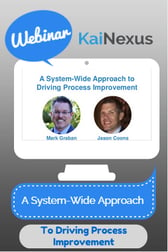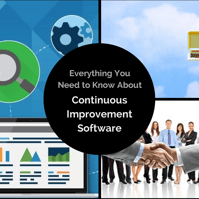
Our Customers: Kettering Health Network

The Kettering Health network began using the KaiNexus platform in December of 2013. They realize that technology isn't a silver bullet that will solve organizational or continuous improvement problems. They believe that you must improve People, Process, and Technology, in that order; to simply depend on a technology solution will not allow true transformation to occur.
KaiNexus has not only enabled thousands of hours in waste elimination from our processes, but has also been a catalyst for cultural change across the organization.
- Andy Lehman | Senior VP, IT and Analytics
With the use of KaiNexus as a platform to drive change, the Kettering Health Network has developed strong leadership engagement in their improvement efforts and empowered front line staff to truly use their creativity and problem solving to make a difference each day.
Since deploying KaiNexus, Kettering has entered close to 700 opportunities for improvement, completing nearly 55%, and yielding impacts across both hard and soft savings. Most impactful has been on the culture to drive daily improvement to yield higher levels of value in the work being performed.
One of the ways that Kettering measures this improvement is through time savings being freed up to improve value added work. Since launching KaiNexus, Kettering has freed up over 35,000 hours of time for leaders and staff.
KaiNexus has allowed us to create a source of truth for our continuous improvement across the organization. Whether we are a leading project, rapid improvement event, training, or deploying strategy, KaiNexus provides a standard platform for accountability during implementation.
- Jason Coons | Director of Process Excellence
Important in creating a culture of continuous improvement is helping leaders understand their role. The Kettering Health Network realized that by not addressing role clarity for leaders, they could jeopardize the impact that KaiNexus could have in supporting their goals.
The below instructions for KaiNexus use are sent out to managers and supervisors as guidelines for appropriate behavior to guide staff in engaging in the improvement process. We thought it was so good we asked them if we could share it.
(The below messaging has been reprinted with permission, and adapted for clarity).
Key Points for Leaders Using KaiNexus:
When someone submits an improvement (OI):
- Get as engaged as possible
- Read the OI fully
- Walk over and engage the author in conversation
- If you think the OI is not filled in properly or is not clear, help the author develop and define the key points of their idea
- If the idea will require other people to get involved, help the author identify the who (teams and individuals).
Questions to ask and prompts:
- Can you describe the opportunity for improvement in the form of a problem?
- What process is broken? Where is the process broken?
- What do you think we should do about this problem or process issue? What would you do if you were me?
- Is this idea really big? What are the smaller components?
- What would you consider success?
- Where do you see this OI going? Next steps?
It's Important to Remember...
When Capturing OIs:
- Use team meetings and rounding to capture and discuss OIs
- Empower the submitter to be part of the solution
- The solution is not required when entering the OI. The solution may not present itself until some conversation and brainstorming happens. You are brainstorming with them. Involve others.
- When a staff member gets assigned an OI or a task, they receive an email notification. In that notification is a video explaining what to do next - encourage them to watch it… and you should too.
When Working on OIs:
- Assign OIs in a timely manner (less than 2 business days)
- Hold team members accountable for assigning OIs and timely completion of OIs
- Your approach to the staff member MATTERS! If you aren't fully bought in, they won't be either. If you are simply fulfilling the letter of the law then they will see right through you
- Empower staff - don't do the improvement for them
- Support your team through assisting in documentation and removing barriers
- Get out of your chairs and go talk to people
- Don't be hesitant about allowing the OI to evolve. Consult with those involved to make refinements, modify the proposed solution as it evolves, etc.
- Keep the OI current; don't have a conversation and then not update the documentation within the OI.
- Stay involved per your role with the OI:
- Responsible: Ensure that the submitter is comfortable with the direction the OI is heading. It is the responsibility of the person assigned to keep the submitter engaged, making sure the idea is being developed
- Submitter: Stay engaged. Comment on the direction that the idea is taking. If it is going off into left field then say so. - Pull up KaiNexus in your staff meeting and review your team's OIs.
- This is a great time to capture OI's. Document them at that time. Use the "submit on behalf of" feature.
When Resolving OIs:
- An OI should not be closed until the solution has been completed and there is an outcome. How else will you be able to document the impact of the change?
- Don't close something out unless you have discussed with the submitter - ESPECIALLY if it is not resulting in a change
- Make improvement fun; recognize and reward. Point out that your staff are exhibiting the core value of "innovation."
- Be accountable for your teams' success
For more information about Kettering's story, watch this webinar:
A System-Wide Approach to Process Improvement
Duration: 1 hour Hosted By: Jason Coons and Jeff Roussel
Hosted By: Jason Coons and Jeff Roussel
- Get actionable advice from lessons learned in Kettering Health Network's 5 year process improvement journey
- See how Kettering's system-wide approach to projects, training, and daily problem solving led to $2.6 million of financial impact last year
- Learn about KaiNexus, the continuous improvement software platform that spread continuous improvement by enabling change management and accountability within the system



